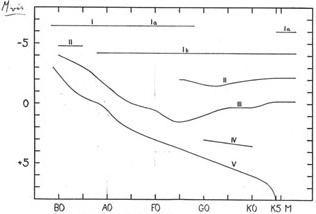

The relation between the revised types of the B2-G0 dwarfs and color is shown in Figure 1. An approximate calibration of the luminosity classes is given in Figure 2. While any definitive calibration requires the use of many more stars than are considered here, we do not think that any of the curves should be in error anywhere by much more than a half-magnitude.
Since about a year was needed for the making of the photographic
prints for the Atlas, there is a difference in epoch of that time
between the classification as illustrated there and as expounded here.
It was unavoidable that certain improvements and alterations should
have suggested themselves in the interim. These have been incorporated
in the text; and there are therefore several discrepancies between the
Atlas plates and the text. In all such cases the text is to be taken
as final, and the data on the Atlas prints should be altered to agree
with the outline. The most important of the changes has been the
shifting in spectral type of two standard stars. These are µ Peg
(Plates 36, 41,
44), whose type should be changed from G5 to G8, and
 2 UMa
(Pl. 37),
whose type has been altered from F8 to F6.
2 UMa
(Pl. 37),
whose type has been altered from F8 to F6.
The characteristics of the system described here can be summarized as follows: The two-dimensional classification can be used to describe accurately the spectra of the normal stars brighter than the eighth apparent magnitude. Since this includes all but a very small percentage of the total number of stars brighter than that limiting magnitude, it is possible to derive from the extension of the classification to fainter objects certain general information concerning the distribution in space of the stars absolutely brighter than the sun.
In the course of the investigation several interesting details have
been noted. Among the Be stars very broad absorption lines have been
observed, which suggest maximum stellar rotational velocities somewhat
higher than those found earlier. The most striking example of this is
the star  Per. Others stars having
lines suggesting higher rotational velocities than the Bnn star,
Per. Others stars having
lines suggesting higher rotational velocities than the Bnn star,
 UMa, are
UMa, are
 Oph, 25 Ori, and
Oph, 25 Ori, and
 Mon A.
Mon A.

|
Figure 2. Preliminary calibration of luminosity classes in terms of visual absolute magnitude. |
Also of interest is the discovery of similar spectral peculiarities
in several G- and K-type high-velocity giants. The high-velocity stars
 Lep, Boss 2527,
Lep, Boss 2527,
 Leo, and probably
a Boo have similar peculiar
features. The most striking of these on low dispersion is the abnormal
weakness of the CN absorption extending toward the violet from
Leo, and probably
a Boo have similar peculiar
features. The most striking of these on low dispersion is the abnormal
weakness of the CN absorption extending toward the violet from
 4215.
4215.
When carefully calibrated, the luminosity classification should allow the determination of accurate spectroscopic parallaxes on low-dispersion plates of stars of all classes from O9 to M2 (with the possible exception of classes B8-A2).
The spectral classification defines with accuracy a system of color standards which can be used in investigations of interstellar absorption and determinations of systematic errors in spectral classification of faint stars. It should be emphasized that the actual features used for classification are dependent on the dispersion used and that some or most of the criteria listed here might be unsuitable for use on spectra having greatly different dispersion.
We wish to acknowledge our indebtedness to the following persons: to
Dr. Struve for making the publication of the Atlas possible; to Dr.
Joaquin Gallo, director of the Astronomical Observatory of Mexico at
Tacubaya, for the loan of a number of objective-prism plates; to Dr.
A.H. Joy, of Mount Wilson, for determining the spectral types of
several M giants which we have used as standards; to
Dr. A.N. Vyssotsky, of the Leander McCormick Observatory, for several
discussions of the problem of spectral classification; and to Dr. G.P.
Kuiper for a discussion of the dynamical parallax of
 Cygni. We are
also indebted to the following persons for taking a considerable
number of the spectrograms used in the investigation: Mrs. Frances
Sherman Bailey, Dr. J.A. O'Keefe, Dr. L.R. Henrich,
Mr. W.P. Bidelman, and Mr. Frank R. Sullivan. All the photographic
prints for the Atlas were made by Miss Kellman and Miss Phyllis
Anderson.
Cygni. We are
also indebted to the following persons for taking a considerable
number of the spectrograms used in the investigation: Mrs. Frances
Sherman Bailey, Dr. J.A. O'Keefe, Dr. L.R. Henrich,
Mr. W.P. Bidelman, and Mr. Frank R. Sullivan. All the photographic
prints for the Atlas were made by Miss Kellman and Miss Phyllis
Anderson.